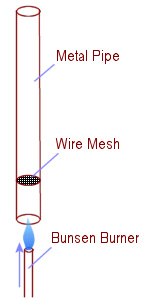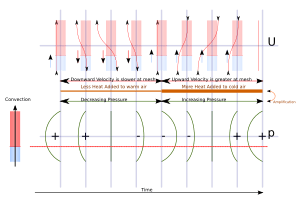Rijke tube facts for kids
Rijke's tube is a cool device that turns heat into sound! It does this by making a special kind of sound wave called a standing wave grow louder and louder on its own. It's a fun thing to see in acoustics (the study of sound) and a great example of resonance, which is when something vibrates strongly at a certain frequency.

Contents
How the Rijke Tube Was Discovered
A Professor's Sound Experiment
Back in 1859, a physics professor named Pieter Rijke at Leiden University in the Netherlands found a new way to make sound using heat. He used a simple tube, open at both ends, to create a continuous sound.
Making Sound with a Hot Mesh
Professor Rijke's tube was made of glass, about 0.8 meters long and 3.5 centimeters wide. He put a round piece of wire gauze (like a fine metal screen) inside the tube. It was placed about 20 centimeters from one end, as you can see in the picture. The gauze stayed in place because of friction with the tube's walls.
He held the tube straight up and heated the gauze with a flame until it was glowing red hot. When he took the flame away, the tube made a loud sound! This sound lasted until the gauze cooled down, which was about 10 seconds. For safety today, people often use tubes made of borosilicate glass or metal.
Continuous Sound with Electricity
Rijke also tried heating the gauze with electricity. He used special resistance wire for the gauze. When enough current flowed through it, the gauze glowed red. With constant heat, the sound became continuous and very loud.
Professor Rijke even reported that his university colleagues complained! The sound was so loud it could be heard three rooms away from his lab. It took about 1 kilowatt of electrical power to make such a strong sound.
Lord Rayleigh's Loud Demonstrations
Lord Rayleigh, a famous scientist who wrote a key book about sound in 1877, thought the Rijke tube was perfect for showing in lectures. He used a cast iron pipe that was 1.5 meters long and 12 centimeters wide. He put two layers of iron wire gauze inside, about a quarter of the way up the tube.
The extra gauze helped keep more heat, making the sound last longer. Lord Rayleigh wrote that the sound became so strong it could actually shake the room!
The "Reverse" Rijke Effect
Interestingly, Rijke's assistant, Johannes Bosscha, noticed something else. A Rijke tube can also make sound if hot air flows through a cold screen. This is like a "reverse" Rijke effect. Another physicist, Peter Theophil Riess, also studied this.
How Does a Rijke Tube Make Sound?
The Secret of Standing Waves
The sound you hear from a Rijke tube comes from a standing wave. This wave has a wavelength that is about twice the length of the tube. This creates the tube's lowest, or fundamental frequency, sound. Lord Rayleigh was the first to correctly explain how this sound is made.
Air Flow and Heat Transfer
The air moving past the hot gauze does two things at once. First, there's a steady upward flow of air. This is a convection current, caused by the hot gauze heating the air. Second, the air also moves back and forth because of the sound wave itself.
How the Sound Gets Stronger
For half of the sound wave's cycle, air flows into the tube from both ends. This makes the pressure inside the tube reach its highest point. During the other half of the cycle, air flows outwards, and the pressure drops to its lowest point.
When air flows past the hot gauze, it gets heated to the gauze's temperature. Heating the air makes its pressure go up, following the ideal gas law. As air moves upwards past the gauze, most of it is already hot because it just came downwards past the gauze in the previous half-cycle.
However, just before the pressure reaches its maximum, a small amount of cool air comes into contact with the hot gauze. This cool air suddenly gets heated, and its pressure quickly increases. This boost makes the pressure maximum even higher, which helps the sound wave get stronger.
During the other half of the cycle, when the pressure is going down, the hot air above the gauze is pushed downwards past the gauze again. Since this air is already hot, no new heat is transferred from the gauze, so its pressure doesn't change. Because the sound wave is only boosted once per cycle, it quickly grows to be very loud.
Why No Sound When Heating?
This also explains why there's no sound when the flame is still heating the gauze. All the air flowing through the tube is already heated by the flame. So, by the time it reaches the gauze, it's already hot. No new heat is transferred, and no pressure increase happens to boost the sound.
Why Gauze Position Matters
If the gauze is placed in the upper half of the tube, no sound is made. In this case, the cool air coming from the bottom (due to convection) reaches the gauze when the air is moving outwards, just before the pressure reaches its lowest point. A sudden pressure increase from heat transfer at this moment would actually cancel out the sound wave, not make it stronger.
The exact position of the gauze in the lower half isn't super strict. But for the best sound, you need to think about two things. Most heat is transferred where the air moves the most (at the ends of the tube). But the pressure increase helps the sound most where the pressure changes the most (in the middle of the tube). Placing the gauze about a quarter of the way up from the bottom is a good spot to get close to the best performance.
The Rijke tube is a type of "heat engine" or "prime mover" that uses heat to create sound waves. These are also called thermoacoustic devices.
Sondhauss Tube: A Different Kind of Heat Sound
Another Way to Make Sound from Heat
The Rijke tube works with both ends open. But there's another type of tube that can make sound from heat, even if one end is closed. This is called a "Sondhauss tube." Glassblowers first noticed this effect, and the German physicist Karl Friedrich Julius Sondhauss described it in 1850. Lord Rayleigh also explained how the Sondhauss tube works.
How the Sondhauss Tube Works
The Sondhauss tube works in a similar way to the Rijke tube. First, air moves towards the hot, closed end of the tube. As it gets heated there, the pressure at that end goes up. Then, the hot, higher-pressure air flows from the closed end towards the cooler, open end of the tube. As it moves, the air transfers its heat to the tube and cools down.
The air then pushes slightly beyond the open end of the tube, briefly squeezing the air outside. This squeeze travels through the air as a sound wave. The outside air then pushes the air back into the tube, and the whole process starts again.
Unlike the Rijke tube, the Sondhauss tube doesn't need a steady flow of air through it. Also, while the Rijke tube acts like a "half-wave resonator" (meaning its sound wave is half a wavelength long), the Sondhauss tube acts like a "quarter-wave resonator."
Making it Stronger
Just like with the Rijke tube, scientists found that adding a porous heater and a "stack" (a porous plug) inside the Sondhauss tube made it much more powerful and efficient. For demonstrations, you can heat the tube from the outside, and steel wool can work as a stack.


